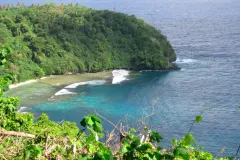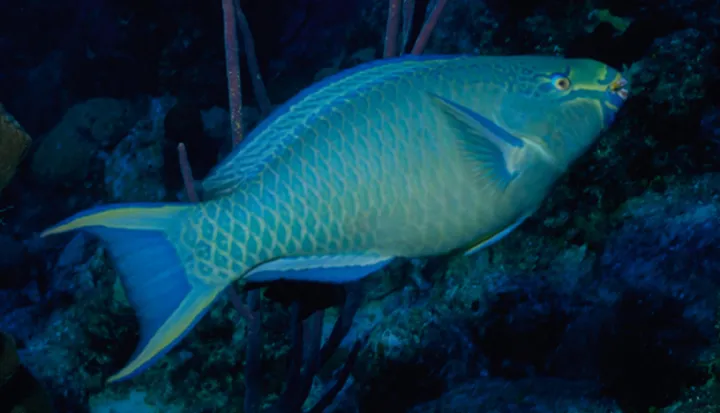The Reefs of American Samoa: A Story of Hope

Sometimes called the rainforests of the sea, coral reefs are incredibly diverse and complicated systems. Because of this complexity, it can be a challenge to manage and protect reefs—and sometimes multiple threats must be addressed in quick succession. Overfishing, pollution and coral predators all have negative impacts on coral and the many animals that live on the reef. But with vigilant protection and response to these challenges, coral reefs can be protected. The story of American Samoa shows that reefs can and do rebound if human impacts are minimized.
American Samoa is a string of seven little islands in the South Pacific, 2,500 miles south of Hawaii. Around 55,000 people live in American Samoa and they rely on the 115 square miles of reef for food, jobs and coastal protection. Home to roughly 2,700 known marine species (and undoubtedly vast numbers of unknown species), the reef is an immensely diverse and important ecosystem.
Like many reefs around the world, the coral reefs of American Samoa have been impacted by human activities as well as natural events like cyclones and storms. When it comes to reef protection, there is no one-time simple solution. People in American Samoa have responded to a variety of threats with a variety of solutions.
The first big crisis came in 1978 when a crown-of-thorns starfish outbreak killed roughly 90 percent of all the coral on American Samoa’s reefs. It was a wake up call for scientists and managers that American Samoa’s reefs were in real danger.
In 1986, the Fagatele Bay National Marine Sanctuary was established, the most remote and tropical of the 14 U.S. marine sanctuaries. It was a step in the right direction, but the marine sanctuary was not sufficiently large to adequately respond to the threats of coastal pollution and overfishing. The sanctuary would be expanded in 2012, but remains a small part of the territory’s reefs.
For decades, controlling nutrient runoff onto the reefs has been a major challenge. Between 1954 and 1990, tuna canneries regularly released wastewater into the harbor and onto the reefs. High in nutrients, the tuna wastewater acted as a fertilizer, causing plankton to multiply in the harbor and contributing to a drastic decline of coral in the harbor. In 1991, the government took action: the wastewater pipes were diverted so that they no longer spilled into the harbor or onto the reefs. By the very next year, nutrient levels had decreased.
A few years ago, residents of American Samoa noticed that the harbor once again was in trouble and had changed color to red. Scientists determined that, as before, nutrient run-off was to blame, this time from fertilizer used on a nearby soccer field. The fertilizer was reduced, and the algae growth was controlled. The red harbor water returned to its usual green color. Time and again, this basic act of ensuring that nutrient-rich water is contained and not dumped on the reef has stopped the damaging effects of the nutrients.
The biggest challenge to coral reef protection has been maintaining the delicate balance between the many organisms that live on the reef. Reef algae have an important role to play, but when they grow out of control, they can smother and destroy the coral. Luckily, a reef has many defenders. Plant-eating fish such as parrotfish eat the algae and protect the coral from being smothered.
These fish, important for the reef, are equally important to coastal communities for food, nutrients and jobs. As herbivores, parrotfish cannot be caught with a hook and line because they are not attracted to the bait. In the 1990’s, spearfishing while scuba diving was the most popular method to catch parrotfish. In 2000, spearfishing was banned and now the reefs continue to have strong parrotfish populations and little harmful algae.
Recently, scientists discovered that overfishing had removed a significant number of larger reef fish species, such as sharks, wrasse and grouper. This is very common on reefs all over the world. American Samoa responded to protect these fish by banning all fishing of large reef fish species. Now, more kinds of large reef fish are protected in American Samoa than anywhere else in the world. Fishing of small- and medium-sized fish continues, but not as intensely as in previous decades or as intensely as in many other places in the world. This is because the growing local economy has allowed fishers to find profitable work in other industries and lessened the pressure on fish populations.
Rising to the challenges of predators, pollution and overfishing is not an easy task. Since the mass crown-of-thorns outbreak in 1978, the coral has been gradually returning. Now about 36 percent of the reef area is covered in living coral. Coral has not recovered to levels seen before the first crown of thorns outbreak, but compare present coral levels to the Caribbean’s roughly 16 percent coral cover or the Great Barrier Reef’s 14 percent coral cover inshore and you see that the reefs are in relatively good shape. Even in the last nine years, the coral cover has increased from 25 percent to 36 percent in American Samoa. This rebound is due to a combination of good protection efforts and good luck.
The lesson of American Samoa is clear: the work of coral reef protection is never truly finished. Despite these many efforts, the reefs in American Samoa are always in danger of their next assault. Crown-of-thorns starfish outbreaks, red tides, sediment runoff, and hurricanes can do real damage to the reef, and global climate change threatens reefs in the future. Even now, a new infestation of crown-of-thrones starfish is building on the reefs with efforts in place to remove them before they decimate the coral again. But the moral of the story is that a healthy reef can bounce back and recover. When coral reefs are healthy, they have the best chance possible to survive, thrive, grow, and provide benefits to people.
Reference: The State of Coral Reef Ecosystem of American Samoa (PDF).



